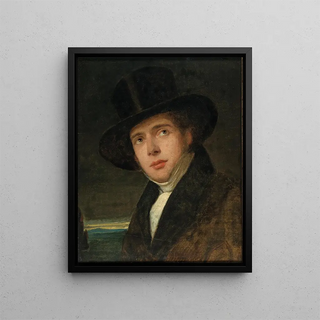Art print | Portrait of his brother Andreas - Friedrich von Amerling


View from behind

Frame (optional)
In the artistic landscape of the 19th century, the portrait emerges as a privileged genre, revealing both the personality of its subjects and the virtuosity of the artist. "Art print of his brother Andreas" by Friedrich von Amerling stands out for its intimate approach and its ability to capture the very essence of the individual. This work, imbued with tenderness and delicacy, invites us to delve into the artist's universe, while prompting reflection on family relationships and the representation of identity. Through this portrait, Amerling does not merely depict his brother; he immortalizes a moment, an emotion, a connection that transcends time.
Style and uniqueness of the work
Friedrich von Amerling's style is characterized by remarkable finesse, both in the choice of colors and in the rendering of textures. In "Art print of his brother Andreas," the delicate palette evokes a soft and warm atmosphere, where skin tones harmonize with the refined clothing of the model. Every detail, from the contemplative gaze to the folds of the garment, is treated with meticulous precision, demonstrating the technical expertise of the artist. Amerling manages to create an illusion of depth, inviting the viewer to get closer to the subject and share a moment of intimacy. The subtly orchestrated light plays a key role in this work, highlighting facial features and giving the portrait an almost lifelike dimension. This realism, combined with palpable sensitivity, makes this work a poignant testament to fraternal affection.
The artist and his influence
Friedrich von Amerling, born in 1803 in Vienna, is one of the most renowned portraitists of his time. Trained in the ateliers of great masters, he develops a unique style that combines romanticism and realism. Amerling stands out for his ability to blend academic tradition with a more personal and emotional approach to portraiture. His work is not limited to simple representation; it explores the psychology of the characters, revealing facets of their personality often overlooked. Amerling's influence extends beyond his contemporaries, inspiring many artists to explore the psychological depth of portraits.

Matte finish

View from behind

Frame (optional)
In the artistic landscape of the 19th century, the portrait emerges as a privileged genre, revealing both the personality of its subjects and the virtuosity of the artist. "Art print of his brother Andreas" by Friedrich von Amerling stands out for its intimate approach and its ability to capture the very essence of the individual. This work, imbued with tenderness and delicacy, invites us to delve into the artist's universe, while prompting reflection on family relationships and the representation of identity. Through this portrait, Amerling does not merely depict his brother; he immortalizes a moment, an emotion, a connection that transcends time.
Style and uniqueness of the work
Friedrich von Amerling's style is characterized by remarkable finesse, both in the choice of colors and in the rendering of textures. In "Art print of his brother Andreas," the delicate palette evokes a soft and warm atmosphere, where skin tones harmonize with the refined clothing of the model. Every detail, from the contemplative gaze to the folds of the garment, is treated with meticulous precision, demonstrating the technical expertise of the artist. Amerling manages to create an illusion of depth, inviting the viewer to get closer to the subject and share a moment of intimacy. The subtly orchestrated light plays a key role in this work, highlighting facial features and giving the portrait an almost lifelike dimension. This realism, combined with palpable sensitivity, makes this work a poignant testament to fraternal affection.
The artist and his influence
Friedrich von Amerling, born in 1803 in Vienna, is one of the most renowned portraitists of his time. Trained in the ateliers of great masters, he develops a unique style that combines romanticism and realism. Amerling stands out for his ability to blend academic tradition with a more personal and emotional approach to portraiture. His work is not limited to simple representation; it explores the psychology of the characters, revealing facets of their personality often overlooked. Amerling's influence extends beyond his contemporaries, inspiring many artists to explore the psychological depth of portraits.






